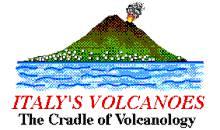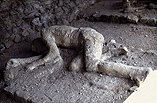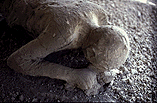| Stromboli
home page |
||
| Eruptive history | Volcanic hazards | References |
| Eruptive characteristics | Geophysical monitoring | Web sites |
| Latest news | ||
The eruption of
A.D. 79
Vesuvio roared into the historic record of the human civilization in August of A.D 79 with what is probably the most famous eruption of history (or at least rivalling that of Mount St. Helens in 1980), and the first ever volcanic event of which a detailed eyewitness description is available. The destruction of the Roman towns of Pompeii and Herculaneum whose spectacular rediscovery in the 18th century and and whose treasures and dead inspire poets, philosophers and scientists to the present days, gives a vivid idea of what Vesuvio is able to do.
The eruption has been, and continues to be, studied by countless scientists from all over the world, and it has been repeatedly re-interpreted in the light of progresses in volcanology. Here I give a summary of the most up-to-date state of knowledge, however pointing to differing, and often disproved, earlier views since many of them are still circulating in the literature. It is based mainly on the landmark papers by Sigurdsson et al. (1982, 1985, 1990) and more recent papers by Lirer et al. (1993, 1997), Cioni et al. (1992, 1995), and Mues-Schumacher (1994). Some of the more recent literature (such as 1997) still has to be worked into the text; I recommend therefore to read these papers. I apologize for any errors or omissions, should they occur, and hope that I will receive constructive comments helping to improve this page.
SUMMARY
The eruption began at about noon on 24 August of A.D. 79, its paroxysmal
phase lasted until the next day but waning, small-scale activity may have
continued for some time (at Pinatubo, in 1991, declining activity continued
for more than 2 months). It erupted about 4 km3
of magma from a zoned magma chamber in less than 24 hours. Airfall tephra
was blown SSE and is traceable up to 74 km away, near Agropoli (at the
bottom right of the isopach map below). Several towns and villages were
completely annihilated, mainly by burial under thick pumice fall deposits
(up to 2.5 m thick in Pompeii) in the SE sector of the volcano, and by
much thicker pyroclastic flow deposits (more than 20 m at Herculaneum)
on the S and W flanks. At least 3600 people were killed (Volcanoes of
the World, 1994 edition). The number of those displaced or otherwise affected
by the effects of the eruption is not known.
The situation before the eruption
The shape of Vesuvio
before the A.D. 79 eruption is still open to speculation. Sigurdsson et
al. (1985) mention two
wall paintings (frescoes), one in Pompeii that shows Vesuvio with one
single summit (image below) and another one at Herculaneum that shows
the volcano with twin summits. A possible explanation for this divergence
could be simply the different view that one has of the volcano from the
two places, with a possible pre-79 caldera hidden from view by a more
recent cone when seen from Pompeii.
The fact that the AD 79 pyroclastic surges and flows did not extend as
far to the N and NW as they did in all other directions points to the
existence of a topographic barrier coinciding with the present location
of the Somma caldera wall before the eruption.
Forerunning phenomena
Premonitory local seismicity began at least several months before the eruption. A major destructive earthquake in A.D. 62 or 63 (i.e., 16 or 17 years before the eruption) is generally cited as the first indicator of the impending eruption. Although the event may have had some triggering effect on the later eruption, Sigurdsson et al. (1985) suggest that it was rather a regional tectonic event that was not directly related to or caused by magma movements below Vesuvio. The Campanian province is tectonically highly unstable and frequently experiences major tectonic earthquakes that affect the Vesuvian region, such as the November 1980 earthquake that caused considerable damage in Napoli and the archaeological sites of Herculaneum and Pompeii.
Sometime during the months preceding the eruption, there were apparently more common precursory phenomena like ground uplift and numerous small local earthquakes. However, there is no reliable information about the timing and scale of such phenomena.
Initial phreatomagmatic activity
Although not described in the famous letters by Pliny the Younger, the first eruptive event at Vesuvio after at least many centuries of repose was a brief but violent phase of phreatomagmatic explosions that produced a relatively small volume (106 m3) of fine-grained, light colored ash rich in accretionary lapilli. The deposit (named A-1 by Sigurdsson et al. 1985) extends towards the E with a maximum thickness of a few cm close to the volcano. Lirer et al. (1993) believe that the deposit was emplaced by some other mechanism than fallout, that is, flow (surge). The A-1 phreatomagmatic explosion probably occurred shortly before the onset of the Plinian phase of the eruption, i.e. on the morning of 24 August 79. It probably caused alarm among nearby residents but there is no evidence of any exodus of the population at that time.
|
Isopach map of the August 79 pumice fall deposits, from Sigurdsson et al. (1985). Blue lines are for the white pumice fall deposit, red lines for the overlying gray pumice fall deposit. |
|
|
|
Thanks to the descriptions by Pliny the Younger, the beginning of the Plinian phase of the eruption is well constrained. From Misenum (now Miseno), some 30 km west of the volcano, Pliny became aware of a tall eruption column above Vesuvio at around 1300 on 24 August. The column had a narrow lower portion and broadened upwards to attain the famous "pine-tree shape" typical for a Plinian eruption column. Calculations by Sigurdsson et al. (1985) give a height of 27 km of the column during this stage, later it rose even to 33 km altitude (see below).
Departing from their prevalent direction (which is usually ENE), high (stratospheric) winds carried the plume towards SSE, thus directly over Pompeii which lay right on the main axis of pumice fallout. Although no eyewitness accounts are available of what happened in Pompeii (and other smaller communities that probably lay in the same area), the situation there must have been dramatic, as is evident from the reconstruction by Sigurdsson et al. (1985). The thickness of the tephra layer in the Pompeii area must have increased by 12 to 15 cm per hour. About 90 per cent of that tephra were pumice clasts. These probably were not responsible for direct fatalities in the city but should have, after a few hours, caused the collapse of roofs. The fall of lithics with sizes of up to 5 cm arriving at speeds of <50 m /second probably caused injuries and isolated deaths, lithics that were produced by the reaming out of the new enlarging conduit as a powerful stream of gas and magma rushed out of the volcano.
A serious problem for the population, and an understandable reason why so many people were still in or near Pompeii when death struck them was the complete darkness caused by the dense eruption plume and the heavy fallout, a phenomenon that has impressed millions of people when Mount St. Helens exploded in May 1980 and that has occurred as well during the 1982 El Chichón (Mexico) and 1991 Pinatubo (Philippines) eruptions. Understandably, the residents of the main fallout area who did not even know what kind of event was striking them considered their homes the safest places and waited there, hoping that the events that terrorized them would sooner or later end.
The deposit of this
phase (A-2, according to Sigurdsson et al. 1985)
is made up of white, crystal-poor pumice of phonolitic composition that
reaches a maximum thickness of 1.3-1.4 m near Pompeii, having been erupted
during seven hours of continuous explosive activity. The eruption then
tapped a lower, less evolved portion of the magma chamber below the volcano,
and gray pumice of tephriphonolitic composition was ejected. The change
in composition was quite sudden, implying a very sharp interface between
the two magma types in the magma chamber (Cioni et al. 1995;
see also Mues-Schumacher 1994
for descriptions of the small-volume white-gray transitional pumice).
At this stage, the eruption siginficantly gained in vigor and the eruption
column rose to 33 km altitude. For five more hours, pumice continued to
fall to the S of the volcano, and by the early morning (about 0100) of
25 August, about 1.5 m of pumice covered the Pompeii area. By this time,
the eruption had affected an area bordered by Terzigno in the E and Oplontis
in the W while the areas beyond, i.e. the W, NW, N and NE flanks of the
volcano had so far received only very light falls of fine ash, if any
at all.
Emplacement of pyroclastic surges and flows
After about 12 hours
of continuous Plinian activity, i.e. the sustained violent outrush of
gas and magma, a change in the eruptive dynamics occurred that would be
fatal to thousands of people around the volcano. It may have been the
widening of the eruptive vent to that degree that the gas pressure thus
distributed over a larger area did no longer manage to only push up a
tall convecting eruption column, the mass eruption rate had increased
or the volatile content of the eruptive magma had decreased; the studies
by Sigurdsson et al. (1985)
imply that all of these factors were actually acting together.
The phenomenon that was caused by these factors was what volcanologists
call the collapse of the eruption column. Part of the erupted mixture
of gas and pyroclastics did no longer rise up convectively, but immediately
fell back onto the upper slopes of the volcano, forming glowing avalanches,
separated in the faster and farther-reaching surges and the denser, slower
and less widespread pyroclastic flows (for definitions of these somewhat
controversial terms, see the glossaries of volcanological terms of Volcano
World and the Volcano
Information Center).
|
|
|
|
|
In their reconstruction of the A.D. 79 eruption, Cioni et al. (1992) visited numerous new quarries and found that a pyroclastic flow (EU-2/3pf in the stratigraphy by Cioni et al. 1992) occurred already at the time of the shift from white to gray pumice. Outcrops with the pyroclastic flow deposit occur close to the volcano on its SE side but are absent in the proximal NE and medial S sector. Possibly, this first flow did not reach very far from the crater.
The first couple
of surge and flow found by Sigurdsson et al. (1985),
named surge S-1 and flow F-1, rushed down the slopes of the volcano at
around 0100 on 25 August. They spread mainly towards S, SW and W, with
the coastal town of Herculaneum lying directly in their path.
For considerable time it has been believed that Herculaneum was not directly
affected by the eruption at all but was only buried by mudflows (lahars)
after the eruption when rainfalls remobilized the tephra deposits
on the higher slopes. Furthermore it was believed that all residents had
fled from that town during the eruption, thus explaining the apparent
lack of victims in Herculaneum. Among the authors advocating the "mudflow"
version of Herculaneum's destruction was Rittmann (1950, cited in Sigurdsson
et al. 1985). Even the
grand French volcanologist Lacroix who had so meticulously studied and
described the 1902-1905 eruption of Montagne Pelée (Martinique,
French Antilles), failed to recognize that the fatal agent for the residents
of both Herculaneum and Pompeii had been a phenomenon very similar to
the one he had introduced to the volcanological community. In his book
about the end of the Montagne Pelée eruption, he explicitly excluded
the occurrence of "nuées ardentes" (pyroclastic flows) during the
79 eruption of Vesuvio (Lacroix 1908).
It was here that they were killed instantly when the surge plunged down on the beach area over the steep hill on which the central part of the town was situated. In the town itself, walls were blown down and rubble from damaged buildings was carried to distances of 2-4 m, testifying to the destructive power of the surge. The people in the boat chambers died, if not from thermal shock, from asphyxiation by inhaling the densely ash-laden surge cloud.
The denser pyroclastic
flow (F-1) immediately followed the surge but was restricted to low-lying
areas. Thus, it did not cover the entire area of Herculaneum but mostly
flowed around it in the N and S to rejoin at the beach.
More surges and flows followed, interrupting the continuing fall of gray
pumice around the volcano that now contained a greater portion of lithics.
Meanwhile at Pompeii, more than 2 m of fallout pumice had accumulated.
The surges and flows spread over increasingly large areas. The third surge
(S-3) occurred at about 0630 on 25 August, extending much farther south
than its predecessors and nearly reaching Pompeii. By this time, Herculaneum
was completely buried under thick pyroclastic flow deposits with almost
no buildings protruding above the newly created surface.
About one hour later, at 0730, another surge (S-4) spread beyond the area
of S-3 and overwhelmed Pompeii, killing all people who were still present
in the town. Although the site must have presented a pitiful sight, with
about 2.4 m of pumice covering streets and buildings and most roofs caved
in, but still there were about 2000 people walking around on top of the
pumice deposit in despair when death struck them.
The death of the Pompeiians has been subject of another serious misinterpretation by former scientists. Generally the view was held that they died either by the sudden burial under the falling pumice, or by inhaling some obscure "poisonous gases" (see, e.g., Lacroix 1908). The fact that virtually all dead occur only on top of the lower 2.4 m of the pumice deposit was not much regarded. Lacroix (1908) even showed photos of some of the spectacular plaster casts of the Pompeiian victims in positions very similar to those he had observed frequently at those killed by a pyroclastic surge in the town of St. Pierre, at Montagne Pelée. Nonetheless he attributed the death of the Pompeiians to poisonous gases.
|
|
|
|
|
By the time of the fifth surge/flow couple, about 2 m of fallout pumice had accumulated at Stabiae (situated about 14 km from the crater, as mentioned above). At about this time very intense seismicity accompanied the ongoing eruption, possibly caused by the initial stages of caldera formation at the volcano. Complete darkness prevailed in the area around Vesuvio, now extending much beyond the area of pumice fallout due to the widespread surges and pyroclastic flows.
The culminating event
came at about 0800 on 25 August when the sixth surge spread radially from
the crater, extending to much greater distances than its predecessors.
At Stabiae, the surge left a 2 cm ash layer. Pliny the Elder, Pliny the
Younger's uncle, probably died at Stabiae from the effects of this surge,
but other people did not. Thus Stabiae must have lain right in the most
distal area of the surge. In fact, Cioni et al. (1992)
note that this flow extended up to 15 km towards S.
Surge S-6 extended also to the W, across the Gulf of Napoli towards Misenum
where Pliny the Younger witnessed that complete darkness fell, moving
him as well as numerous other residents to flee. During the flight, he
noted that a dense black cloud was flowing after him, hugging to the ground,
and farther behind there was "fire" advancing. It is likely that he narrowly
escaped that surge that made it over a distance of about 30 km from the
crater.
Closer to the volcano, the deposit left by S-6 reaches thicknesses of
0.5-1 m and frequently grades upwards into a pyroclastic flow deposit,
as is the case, for example, at Pompeii.
Caldera collapse and waning activity
About 18-19 hours after the beginning of the Plinian eruption, that is, at about 0700-0800 on 25 August, and thus coinciding with the largest surges and pyroclastic flows, the main caldera-forming collapse destroyed most of the pre-existing Vesuvian cone. This event allowed access of great volumes of "thermal fluids" (Cioni et al. 1995) to the magma chamber, thus bringing about another significant change in the eruptive style. Dilute pyroclastic flows and surges were produced by hydromagmatic activity, and a lithic-rich debris flow was emplaced (Cioni et al. 1992). According to their different naming of A.D. 79 stratigraphic units, Cioni et al. (1992) name these units EU-4 to EU-6. For an unknown period, maybe days to weeks, declining but still violent activity produced numerous smaller surges and fall deposits that show strong evidence of magma-water interactions. Some of these deposits have been interpreted as being of laharic origin (e.g., Arnó et al., in Santacroce 1987). In the stratigraphy of Cioni et al. (1992), these final deposits are named EU-7 and EU-8. Interestingly, they show a shift back to the initial more evolved phonolitic composition of the magma.
Volumes of erupted products
According to Sigurdsson et al. (1985), the A.D. 79 eruption erupted about 3.6 km3 of magma together with about 0.4 km3 of lithics. The (inflated) volumes of the pumice deposits are 6.4 km3 for the white pumice and 2.5 km3 for the gray pumice. No lava flows were produced by the A.D. 79 eruption although earlier descriptions ascribe a lava flow on the N side of the Somma edifice to the eruption. Generally, Vesuvio does not appear to emit lava during its violent Plinian eruptions, and no lava outflow has been observed during similar eruptions of other volcanoes.
Copyright © Boris Behncke, "Italy's Volcanoes: The Cradle of Volcanology"



